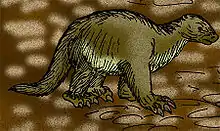Neocnus
Neocnus is an extinct genus of ground sloth, whose species ranged across Cuba and Hispaniola (today split between Haiti and the Dominican Republic). Neocnus would have resembled a typical ground sloth, though much smaller, with a longer tail and a broad trunk, as well as lissome limbs and long claws. This sloth was known for having caudal vertebrae that were broad, a trait shared with other ground sloths, indicating that this animal, like the tamandua of today, likely used its tail to stand upright. The caniniform teeth of the Neocnus were large and triangular, and its skull was deep and had a large, sagittal crest which, when used with the deep mandible likely allowed strong exertion by the masticatory muscles.
| Neocnus Temporal range: Pleistocene to Holocene | |
|---|---|
 | |
| Neocnus comes | |
| Scientific classification | |
| Kingdom: | |
| Phylum: | |
| Class: | |
| Superorder: | |
| Order: | |
| Family: | |
| Genus: | †Neocnus |
| Species | |
| |
The fossils of this sloth were found in Haitian cave deposits. They have been dated to as recently as 4391 BP, calibrated to c. 5000 BP.[2] It is theorized that this sloth, in common with other Antillean sloths, was most likely hunted to extinction by the indigenous peoples of the Caribbean for its pelt and meat. Neocnus is suspected of having been semi-arboreal.[3]
See also
References
- Presslee, S.; Slater, G. J.; Pujos, F.; Forasiepi, A. M.; Fischer, R.; Molloy, K.; Mackie, M.; Olsen, J. V.; Kramarz, A.; Taglioretti, M.; Scaglia, F.; Lezcano, M.; Lanata, J. L.; Southon, J.; Feranec, R.; Bloch, J.; Hajduk, A.; Martin, F. M.; Gismondi, R. S.; Reguero, M.; de Muizon, C.; Greenwood, A.; Chait, B. T.; Penkman, K.; Collins, M.; MacPhee, R.D.E. (2019). "Palaeoproteomics resolves sloth relationships" (PDF). Nature Ecology & Evolution. 3 (7): 1121–1130. doi:10.1038/s41559-019-0909-z. PMID 31171860. S2CID 174813630.
- Steadman, D. W.; Martin, P. S.; MacPhee, R. D. E.; Jull, A. J. T.; McDonald, H. G.; Woods, C. A.; Iturralde-Vinent, M.; Hodgins, G. W. L. (2005-08-16). "Asynchronous extinction of late Quaternary sloths on continents and islands". Proc. Natl. Acad. Sci. USA. National Academy of Sciences. 102 (33): 11763–11768. Bibcode:2005PNAS..10211763S. doi:10.1073/pnas.0502777102. PMC 1187974. PMID 16085711.
- White, J. (1993). "Indicators of locomotor habits in Xenarthrans: Evidence for locomotor heterogeneity among fossil sloths". Journal of Vertebrate Paleontology. 13 (2): 230–242. doi:10.1080/02724634.1993.10011502.
